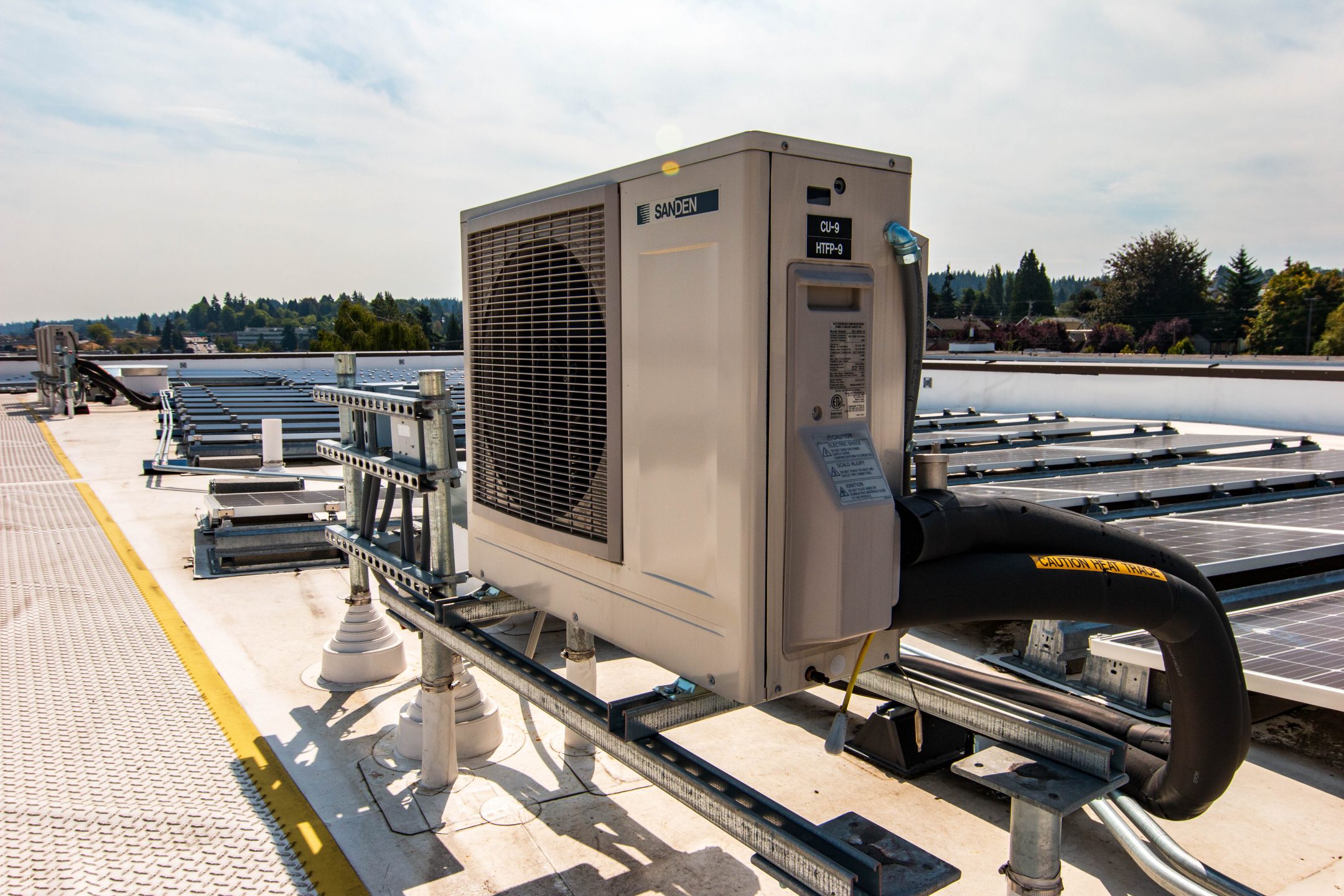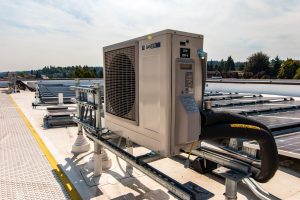
28 Jan Commercial Heat Pump Water Heaters – the Game-Changing Technology We Need Now
BY MADDIE SLIGH, D+R INTERNATIONAL

Rooftop heat exchanger for commercial heat pump water heating system at HopeWorks Station in Everett, WA.
Did you know that a key solution to climate change is a piece of equipment that every building needs, but most people hardly ever think about?
That’s right – we’re talking about water heating systems.
Buildings operations account for 28% of global greenhouse gas emissions and water heating is the second biggest source of energy use in buildings after space conditioning. Commercial buildings – like large multifamily housing, restaurants, lodging, schools, and offices – have huge demand for hot water which has traditionally been served by large centralized fossil fuel systems.
Electric heat pump water heaters have been available for the residential market for over a decade, and now new commercial heat pump water heating (CHPWH) systems are ready at a key moment to meet local, state, federal, and global climate goals.
Here are 4 reasons why energy efficient, all-electric CHPWH systems are the game-changing technology we need now.
- All-electric building codes create the need for commercial building solutions.
All across the U.S., state and local policymakers are fighting climate through building codes and other policies that require or promote net-zero energy and building electrification.
- The city and county of San Francisco conducted an analysis on how to reduce emissions by 80% by 2050 and found that they would not be able to achieve this goal without transitioning to electric heat pumps for space and water heating.
- Seattle City Council adopted gas restrictions that prohibit the use of natural gas for water heating in new hotels and large, multifamily buildings starting in January 2022. This is one of the many components in Seattle’s plan to reduce fossil fuel emissions in the coming years.
- California’s energy code highlights energy and water efficiency standards including efficiency thresholds for water heaters that would require heat pump technology. California is in the process of approving their 2022 energy code which, if approved, would go into effect in 2023.
- New York City recently adopted a plan to gradually ban gas hook-ups for new buildings, eventually requiring new buildings of all sizes to be fully electric 2027. New York state lawmakers are considering similar requirements as well.
- Fully-packaged commercial heat pump water heating systems open up new opportunities for multifamily housing and other commercial buildings.
This technology has been used in commercial buildings in Europe and Asia for years, but has not yet been widely adopted in the U.S. despite proven performance above code. One new development in the technology that could accelerate adoption is the introduction of fully-packaged, plug-and-play systems – like the one that was recently installed in Seattle’s Bayview Tower. CHPWHs consist of multiple components including primary HPWHs, primary hot water storage, temperature maintenance systems, and controls. Concentrating these components into a single, skid-mounted box that can be dropped into place on a roof or in a garage greatly simplifies the design and installation process. Streamlining this process reduces costs and improves return-on-investment for building owners.
- CHPWHs are a cost effective water heating option for building owners and operators.
CHPWHs are an important energy reducing solution especially for multifamily buildings, where they can yield 15-20 percent energy savings according to a study by Ecotope. Upfront costs of CHPWHs are becoming cost competitive compared to other water heating options and boast significantly lower operational costs than other water heating methods. In Washington State, a demonstration project in a 60-unit multifamily senior housing building reduced water heating energy by 70% for a total operational cost savings of $29,750 less than electric resistance water heaters over the lifetime of the equipment. This number would vary by location depending on electricity costs and climate factors in the area.
- CHPWHs can combat climate change even more by enabling demand response and using low global warming potential refrigerants.
Utilities could benefit from the communication functionality offered by many commercial heat pumps. CTA-2045 Modules (EcoPorts) are USB ports that allow CHPWHs to communicate with the grid and many CHPWHs are designed with these included. This communication module enables water heaters to participate in demand response events and to avoid peak pricing. A Bonneville Power Administration study on the Pacific North West showed that if 26.5% of customers in that area enrolled in a demand response program, there would be 301 MW of demand response potential in Oregon and Washington by 2039, which they believe to be a conservative estimate.
In addition to the energy saving potential of this technology, CHPWHs are becoming more climate friendly by moving water heating away from high global warming potential (GWP) refrigerants (HFCs) with GWPs above 1,000, to using R-744a (CO2), which has a GWP of 1. GWP is a measure of how much one ton of the gas will heat the atmosphere compared to CO2. The U.S. is prioritizing shifting to low global warming potential (GWP) refrigerants as a method of reducing the carbon footprint of US buildings by 50% by 2035. Targeting zero net energy buildings, incentivizing deep retrofits, and accelerating the adoption of new and more stringent building codes are also ways the U.S. is working towards achieving this goal.
Education is needed for wider market adoption
With commercial HPWH systems becoming more widely available, one significant barrier remains: training architects, engineers, and contractors to be able to design and implement these systems in a wide range of building types.
D+R LEARN has developed an extensive curriculum to educate professionals on all elements of system design, operation, maintenance, and installation. These on-demand resources are available at no cost through April 15, 2022 thanks to a sponsorship from San Diego Gas & Electric.
To learn more about CHPWHs, explore D+R LEARN’s online on-demand modules and calendar of complimentary live instruction.
Want to hear more about what we’re learning? Subscribe for updates below and follow us on social media!

